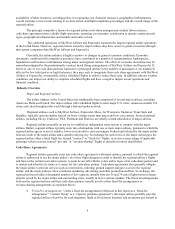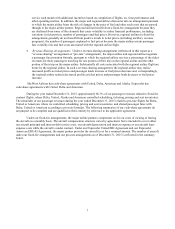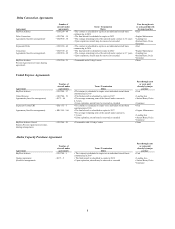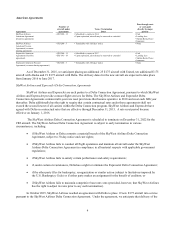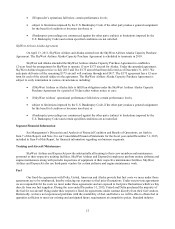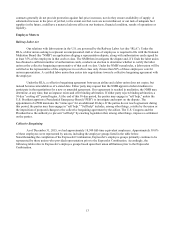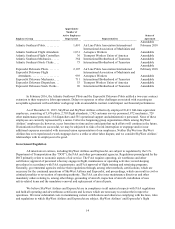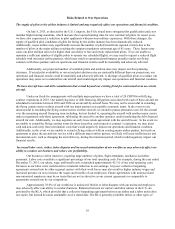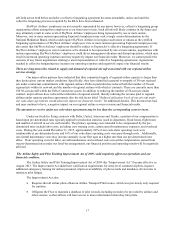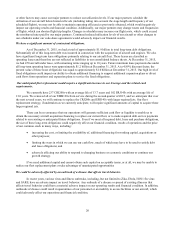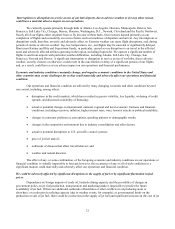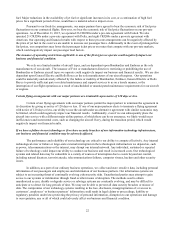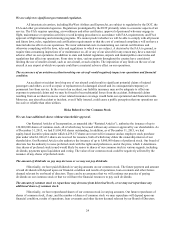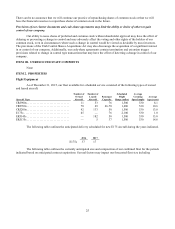SkyWest Airlines 2015 Annual Report Download - page 20
Download and view the complete annual report
Please find page 20 of the 2015 SkyWest Airlines annual report below. You can navigate through the pages in the report by either clicking on the pages listed below, or by using the keyword search tool below to find specific information within the annual report.16
Risks Related to Our Operations
The supply of pilots to the airline industry is limited and may negatively affect our operations and financial condition.
On July 8, 2013, as directed by the U.S. Congress, the FAA issued more stringent pilot qualification and crew
member flight training standards, which increase the required training time for new commercial pilots. In recent years,
we have also experienced a reduction in pilot applicants with previous military experience. With these changes, the
supply of qualified pilot candidates eligible for hiring by the airline industry has been dramatically reduced.
Additionally, major airlines may significantly increase the number of pilots hired from regional carriers due to the
number of pilots at the major airlines reaching the statutory mandatory retirement age of 65 years. These factors may
cause our pilot attrition rates to be higher than our ability to hire and retain replacement pilots. If we are unable to
maintain a sufficient number of eligible pilots to operate our scheduled flights, we may need to request a reduced flight
schedule with our major airline partners, which may result in operational performance penalties under our flying
contracts with those partners and our operations and financial results could be materially and adversely affected.
Additionally, our projected number of available pilots and attrition rates may impact our fleet planning
decisions. If actual pilot availability or our actual pilot attrition rates are materially different than our projections, our
operations and financial results could be materially and adversely affected. A shortage of qualified pilots to conduct our
operations may cause us to underutilize our aircraft and would negatively impact our operations and financial condition.
We have aircraft lease and debt commitments that extend beyond our existing fixed-fee contractual term on certain
aircraft.
Under our fixed-fee arrangements with multiple major partners we have a total of 20 CRJ700s with flying
contract expirations in 2016. Our underlying lease or debt financing obligations associated with each of these aircraft are
scheduled to terminate between 2018 and 2024 on an aircraft-by-aircraft basis. We may not be successful in extending
the flying contract term on these aircraft with our major partner at acceptable economic terms. In the event we are
unsuccessful in extending the flying contract terms on these aircraft, we intend to pursue alternative uses for the aircraft
over the remaining aircraft financing term including, but not limited to, operating the aircraft with another major carrier
under a negotiated code-share agreement, subleasing the aircraft to another operator, and/or marketing the debt financed
aircraft for sale. Additionally, we may negotiate an early lease return agreement with the aircraft lessor. In the event we
are unable to extend the flying contract terms for these aircraft at each respective contract’s expiration, we may incur
cash and non-cash early lease termination costs that would negatively impact our operations and financial condition.
Additionally, in the event we are unable to extend a flying contract with an existing major airline partner, but reach an
agreement to place the aircraft into service with a different major airline partner, we likely will incur inefficiencies and
incremental costs, such as changing the aircraft livery, during the transition period, which would negatively impact our
financial results.
Increased labor costs, strikes, labor disputes and increased unionization of our workforces may adversely affect our
ability to conduct our business and reduce our profitability.
Our business is labor intensive, requiring large numbers of pilots, flight attendants, mechanics and other
personnel. Labor costs constitute a significant percentage of our total operating costs. For example, during the year ended
December 31, 2015, our salary, wage and benefit costs constituted approximately 42.1% of our total operating costs.
Increases in our labor costs could result in a material reduction in our earnings. Any new collective bargaining
agreements entered into by other regional carriers with their work forces may also result in higher industry wages and
increased pressure on us to increase the wages and benefits of our employees. Future agreements with unionized and
non-unionized employees may be on terms that are not as attractive as our current agreements or comparable to
agreements entered into by our competitors.
Approximately 38.0% of our workforce is unionized. Strikes or labor disputes with our unionized employees
may adversely affect our ability to conduct business. Relations between air carriers and labor unions in the U.S. are
governed by the RLA, which provides that a collective bargaining agreement between an airline and a labor union does
not expire, but instead becomes amendable as of a stated date. The RLA generally prohibits strikes or other types of


